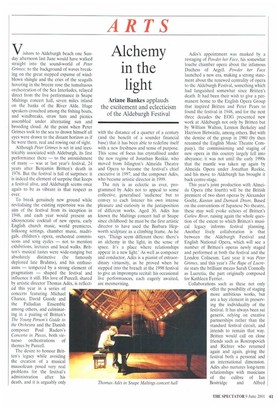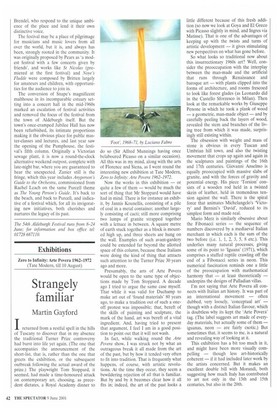Alchemy in the light
Ariane Bankes applauds the excitement and eclecticism of the Aldeburgh Festival
isitors to Aldeburgh beach one Sunday afternoon last June would have walked straight into the sound-world of Peter Grimes: to the background of waves breaking on the great stepped expanse of windblown shingle and the cries of the seagulls hovering in the breeze rose the tumultuous orchestration of the Sea Interludes, relayed direct from the live performance in Snape Maltings concert hall, seven miles inland on the banks of the River Aide. Huge speakers crouched among the fishing boats, and windbreaks, straw hats and picnics assembled under alternating sun and brooding cloud. At the point when Peter Grimes took to the sea to drown himself all eyes were drawn to the distant horizon as if he were there, real and rowing out of sight.
Although Peter Grimes is set in and inextricably associated with Aldeburgh, its first performance there — to the astonishment of many — was at last year's festival, 24 years after Benjamin Britten's death in 1976. But the festival is full of surprises: it is indeed the element of surprise that keeps a festival alive, and Aldeburgh seems once again to be as vibrant in that respect as ever.
To break genuinely new ground while revitalising the existing repertoire was the aim of the festival from its inception in 1948, and each year would present an idiosyncratic cocktail of new opera, early English church music, world premieres, folksong settings, chamber music, madrigals, children's opera, orchestral commissions and song cycles — not to mention exhibitions, lectures and local walks. Britten's musical tastes were wide-ranging but absolutely distinctive (he famously deplored late Brahms), and his enthusiasms — tempered by a strong element of pragmatism — shaped the festival and influence it still. His love of Purcell, shared by artistic director Thomas Ades, is reflected this year in a series of concerts featuring Michael Chance, David Goode and the Palladian Ensemble among others, and culminating in a pairing of Britten's The Young Person's Guide to the Orchestra and the Danish composer Poul Ruders's Concerto in Pieces, both virtuoso orchestrations of themes by Purcell.
The desire to honour Britten's legacy while avoiding the creation of a musical mausoleum posed very real problems for the festival's administration after his death, and it is arguably only with the distance of a quarter of a century (and the benefit of a sounder financial base) that it has been able to redefine itself with a new freshness and sense of purpose. This sense of focus has crystallised under the new regime of Jonathan Reekie, who moved from Islington's Almeida Theatre and Opera to become the festival's chief executive in 1997, and the composer Ades, who became artistic director in 1999.
The mix is as eclectic as ever, programmed by Ades not to appeal to some collective, generalised 'audience' but to convey to each listener his own intense pleasure and curiosity in the juxtaposition of different works. Aged 30, Ades has known the Maltings concert hall at Snape since childhood: he must be the first artistic director to have used the Barbara Hepworth sculpture as a climbing frame. As he says. 'Things seem different there: there's an alchemy in the light, in the sense of space. It's a place where relationships appear in a new light.' As well as composer and conductor, Ades is a pianist of extraordinary virtuosity, as he proved when he stepped into the breach at the 1998 festival to give an impromptu recital: his occasional live performances, each eagerly awaited, are mesmerising.
Ades's appointment was marked by a restaging of Powder her Face, his somewhat louche chamber opera about the infamous Duchess of Argyll. Powder her Face launched a new era, making a strong statement about the renewed centrality of Opera to the Aldeburgh Festival, something which had languished somewhat since Britten's death. It had been their wish to give a permanent home to the English Opera Group that inspired Britten and Peter Pears to found the festival in 1948, and for the next three decades the EOG presented new work at Aldeburgh not only by Britten but by William Walton, Lennox Berkeley and Harrison Birtwistle, among others. But with the demise of the group in 1980 (by then renamed the English Music Theatre Company), the commissioning and staging of new opera in this country largely fell into abeyance; it was not until the early 1990s that the mantle was taken up again by Almeida Opera under Jonathan Reekie, and his move to Aldeburgh has brought it back centre-stage.
This year's joint production with Almeida Opera (the fourth) will be the British premiere of two short operas by Alexander Goehr, Kantan and Damask Drum. Based on the conventions of Japanese No theatre, these may well evoke echoes of Britten's Curlew River, raising again the whole question of the extent to which Britten's musical legacy informs festival planning. Another lively collaboration is that between the Aldeburgh Festival and English National Opera, which will see a number of Britten's operas newly staged and performed at both the festival and the London Coliseum. Last year it was Peter Grimes, and this year's The Rape of Lucretia stars the brilliant mezzo Sarah Connolly as Lucretia, the part originally composed for Kathleen Ferrier.
Collaborations such as these not only offer the possibility of staging more ambitious works, but are a key element in preserving the individuality of the festival. It has always been sui gerteris, relying on creative partnerships rather than the standard festival circuit, and intends to remain that way. Britten would call on close friends such as Rostropovich and Richter who returned again and again, giving the festival both a personal and an international dimension. Ades also nurtures long-term relationships with musicians of the calibre of Ian Bostridge and Alfred Brendel, who respond to the unique ambience of the place and lend it their own distinctive voice.
The festival may be a place of pilgrimage for musicians and music lovers from all over the world, but it is, and always has been, strongly rooted in the community. It was originally proposed by Pears as 'a modest festival with a few concerts given by friends', and works like St Nicolas (premiered at the first festival) and Noyes Fludde were composed by Britten largely for amateurs and children, with opportunities for the audience to join in.
The conversion of Snape's magnificent malthouse in its incomparable estuary setting into a concert hall in the mid-1960s marked an escalation of festival activities and removed the focus of the festival from the town of Aldeburgh itself. But the town's once-cramped Jubilee Hall has now been refurbished, its intimate proportions making it the obvious place for public master-classes and lectures, and last year saw the opening of the Pumphouse, the festival's fifth column. Originally a Victorian sewage plant, it is now a round-the-clock alternative weekend outpost, complete with late-night bar, where you are guaranteed to hear the unexpected. Zanier still is the fringe, which this year includes Anyperson's Guide to the Orchestra, commissioned from Rachel Leach on the same Purcell theme as The Young Person's Guide. It's back to the beach, and back to Purcell, and indicative of a festival which, for all its invigorating new initiatives, both cherishes and nurtures the legacy of its past.
The 54th Aldeburgh Festival runs from 8-24 June; for information and box office tel: 01728 687110.



































































 Previous page
Previous page